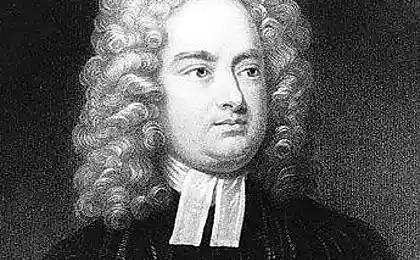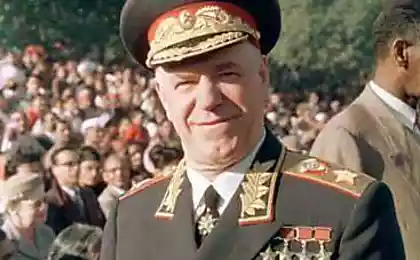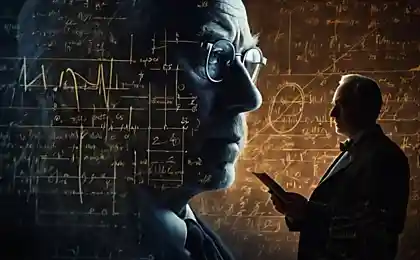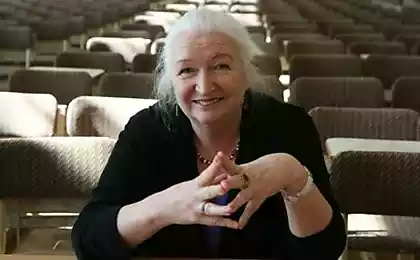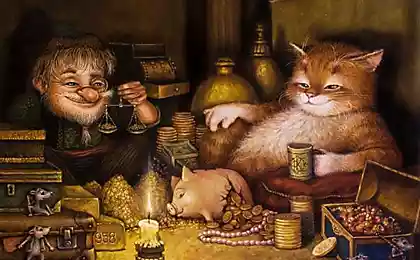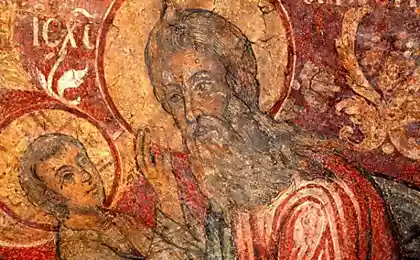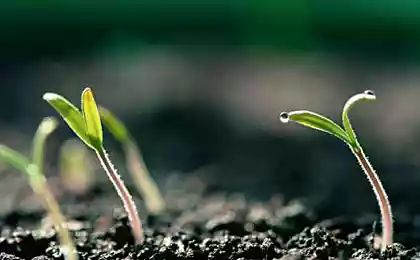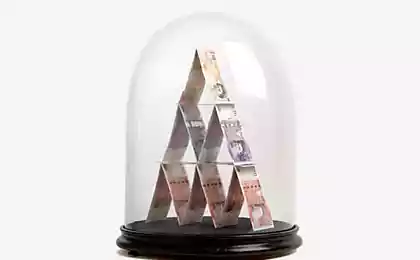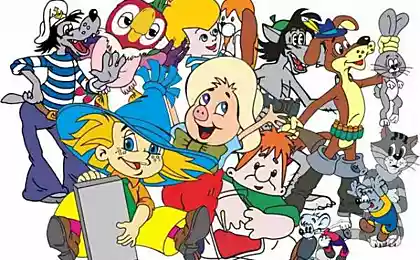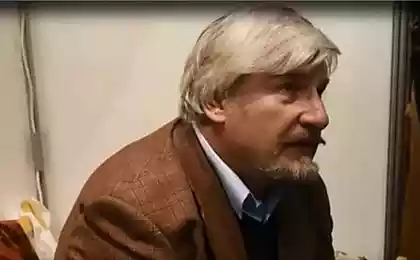217
10 living recognized geniuses
“Glory is in the hands of labor,” said Leonardo da Vinci, and was undoubtedly right, but besides hard work, sometimes even a little talent is necessary. Who knows what path the history of mankind would have taken without the birth of at least one of them – geniuses who transformed the world. Here are just some of the great ones living today.
1. Tim Berners-Lee – The Spider Who Weaved the World Wide Web
British scientist and inventor Sir Timothy John Berners-Lee is not accidental head of the World Wide Web Consortium - after all, he invented the Internet, as well as implemented many other developments in the field of information technology.
Back in 1989, working on the project of internal document exchange ENQUIRE for CERS (European Laboratory for Nuclear Research), Timothy came to create a global hypertext project, approved and later called the World Wide Web. The basis was a system of hypertext documents communicated between themselves by hyperlinks - all this made possible the revolutionary developments of Berners-Lee: HTTP (Hypertext Transfer Protocol), URI identifier (and its version - URL), HTML language. He created the world’s first web server, httpd, and the world’s first website, http://info.cern.ch, which was launched on August 6, 1991 (now in the archives of the Internet). The genius also wrote the first Internet browser for a NeXT computer.
In 1994, T. Berners-Lee at the Laboratory of Informatics at the Massachusetts Institute of Technology founded the World Wide Web Consortium, its head he is now: the Consortium is engaged in the development of Internet standards.
Now the creator of the Internet wants to go even further: he hopes to create a semantic web — a superstructure above the World Wide Web, which will raise the interaction of computers around the world to an absolutely incredible level. The point is that machines will have access to well-structured information available to any client application, no matter what programming language they are written in: computers will be able to exchange information directly, without human intervention, perhaps leading to the creation of World Artificial Intelligence.
2. George Soros, Financial Robin Hood
He is one of the most controversial figures on the global economic scene: some call him a financial fraudster and speculator, while others credit him with a brilliant financial sense.
George Soros was “made” by “Black Wednesday” – September 16, 1992, when there was a “collapse” of the British pound sterling in the foreign exchange market. It was rumored that he himself made this collapse, buying up pounds for several years, and then exchanging them for the German mark at a speculative rate: the pound collapsed, and George, using reserve funds, earned $1-1.5 billion on its purchase in one day, according to various estimates. This legend is not quite true: the “lucky” himself admitted only that having shares for $ 7 billion, he bluffed, bringing the amount of transactions to $ 10 billion.
The scandalous investor developed the “theory of reflexivity of stock markets”, which states that securities are bought up depending on expectations of their future value, and expectations are thin, it is subject to information attacks from the financial media and the actions of market destabilizing speculators.
George Soros’ grandiose intricate financial activities have one bright side: back in 1979, he created the Open Society Foundation in the United States. In 1988, one of the divisions of the foundation appeared even in the USSR, but because of Soviet partners, the Cultural Initiative Foundation was quickly shut down. In 1995, the Open Society itself came to Russia, thanks to the program “University Internet Centers” 33 Internet centers appeared in Russia. However, in 2003, Soros officially curtailed his charitable activities in Russia.
3. Matt Groening, author of The Simpsons and Futurama
The world-famous cartoonist insists that his surname is pronounced Groening - the quirks of genius, nothing can be done: this is reflected in his appearance in The Simpsons, where the surname is pronounced that way.
Matthew showed an aptitude for journalism and animation from school, and after arriving in Los Angeles, he began drawing comics describing how he lived in the big city.
Impressions from Los Angeles, apparently, were not very, since the comics were called "Life in Hell": Matt had to work as a record seller, a journalist, a courier and even a director’s chauffeur.
In 1978, the comic book was published by the avant-garde magazine Wet Magazine, and in 1980 - the Los Angeles Reader. Groening was later invited to write a column about rock and roll, but he wrote mostly about what he saw during the day, recalled his childhood, shared his thoughts on life - in general, he was fired.
In the late 1980s, Groening created a series of posters for Apple featuring his comic book characters, of course.
In 1985, he was approached by producer James Brooks to draw short animated sketches for The Tracey Ullman Show, but Groening came up with something else: a family of Simpsons living at 742 Evergreen Alley, Springfield.
4. Nelson Mandela lifted South Africa from its knees
Mandela’s life is a vivid example of a non-violent, but no less stubborn and difficult struggle: already in his first year at Fort Hare University (the only institution of higher education in South Africa at that time where blacks could study), he took part in a boycott of Fort Hare’s policy and refused to take a seat on the Representative Student Council, after which he left the university. While studying law at the University of the Witwatersrand, Mandela met future associates in the fight against apartheid policy - Harry Schwartz and Joe Slovo (the latter would later take a seat in the government of Mandela).
In the 1940s, Nelson became interested in liberal-radical ideas, became interested in political life and participated in protest demonstrations, and in 1948 he was elected secretary of the Youth League of the African National Congress (ANC), which began his ascent to the ladder of political career.
The political path of Nelson Mandela was long and thorny: years of struggle (including sabotage and preparation of a real sabotage war against the South African government) with the oppression of the black population, a trial, and finally - 27 years in prison. After gaining his freedom in 1990, Mandela again became the leader of the ANC, which by then was already a legal political party, and in 1993 received the Nobel Peace Prize. He became South Africa’s first black president by election in 1994, and served until 1999.
5. Frederick Sanger, twice Nobel chemist
In his youth, Sanger intended to follow in the footsteps of his father (who worked as a doctor), but later became interested in biochemistry and did not fail. Many years later, he wrote, “It seemed to me that this was the way to a real understanding of living matter and to the development of a more scientific basis for solving many of the problems facing medicine.”
The world's only two-time Nobel Prize winner in chemistry, Sanger since the 1940s studied the structure of amino acids and the properties of insulin, in 1955 for the first time presented a detailed description of the insulin molecule, thus laying the foundation for research on the molecular composition of proteins - it was his first "Nobelevka", which found the hero in 1958. Sanger’s research made it possible to produce artificial insulin and other hormones.
Long years of work on the decoding of DNA allowed the chemist in 1973 to create an analytical method for installing sequences of nucleotide chains - this development in 1980 again made him a Nobel laureate along with Paul Berg and Walter Gilbert.
Now Sanger retired and enjoys a quiet family life in Cambridge with his wife Margaret Joan Hove (marriage registered in 1940), they have three children.
6. Dario Fo, Nobel Prize-winning Theatre
You can tell everything about this person with quotes, but it is better to leave you the opportunity to independently discover his work if you are unfamiliar with him. Only in a few words: it is a fountain of witty political and religious satire, acting, jokes and farce – a fountain that, contrary to the well-known expression of Kozma Prutkov, does not want to shut up.
Dario Fo is an Italian director, playwright, and actor whose tireless work and undoubted genius have made him the greatest figure of theatrical Europe in the last half century. The main motive of his work has always been to ridicule the authorities, whether political, ecclesiastical or not.
While still a student, Dario began writing sketches, monologues, and short stories. Since the 1950s, Fo has acted in films, created scripts and plays, and toured with his own theater group, actively expressing his left-wing political views.
In 1997, Dario Fo received the Nobel Prize in Literature, his diploma says: “for inheriting medieval buffoons, boldly criticizing the authorities and defending the dignity of the oppressed.” He joked, “I write novels too, but I don’t show them to anyone.”
“The artist is in the crosshairs of power and power is in the crosshairs of the artist”, “Theatre, literature, art, which do not speak for their time, do not represent value” – all this is Dario Fo.
7. Stephen Hawking, Professor of Mathematics with No Mathematical Education
Hawking is known for his studies of the structure of black holes and work on quantum gravity: in 1975, he created the theory of “evaporation” of black holes – this phenomenon was called “Hawking radiation”. The field of interest of the famous theoretical physicist is the whole universe, he has published several popular science books devoted to its birth and development, the interaction of space and time, superstring theory, and many other interesting problems of modern physics and cosmology.
In his first year of teaching mathematics at Oxford, Hawking was reading a textbook just two weeks ahead of his students.
In 2003, he gave a somewhat pessimistic forecast of human development in an interview: according to him, we will have to move to other planets, because viruses will dominate the Earth.
Back in the 1960s, Stephen began to show signs of CNS disease, which later led him to almost complete paralysis of the limbs - since then he moves in a special chair, which he controls through sensors on some muscles that have retained mobility. In communication with people, he is helped by a computer and a speech synthesizer, which friends gave him in 1985.
Serious illness did not break the character of the great scientist - he lives an interesting, active and, as they say, full life.
8. Philip Glass, great minimalist
An American composer whose work is rooted in the Indian musical tradition, it can be said that Philip absorbed the music along with his mother’s milk: his father owned a record store. Fateful was the trip of a 17-year-old boy to Paris – from there begins his ascent to the peaks of the musical Olympus.
Glass traveled to India for several years, where he met the 14-year-old Dalai Lama, and has been an ardent supporter of Tibetan autonomy ever since. The genius of Glass was formed under the influence of Bach, Mozart, French avant-garde and legendary Indian musician Ravi Shankar.
The main thing in the composer’s work is rhythm: his melodies are simple, but expressive, he is stubbornly called a minimalist, but he himself rejects minimalism.
World fame in 1984 brought Glass collaboration with director Godfrey Reggio in the creation of documentaries: in these films, music is not a background and not an auxiliary visual tool, it is the main character. Before that, Philip’s most famous work was the opera Einstein on the Beach.
In the same 1984, Glass wrote music for the opening ceremony of the Olympic Games in Los Angeles, his other famous works are music for the films Candyman, The Truman Show and The Illusionist.
When Glass was asked, “What kind of music should everyone hear?” he replied, “The music of their own heart.”
9. Grigory Perelman, genius in isolation
Our brilliant compatriot stirred up the world scientific community in the 1990s with his sensational works on geometry, mathematics and physics, but he was truly world famous for two proofs of the Poincaré hypothesis, one of the so-called “Millennial Mysteries”, and the rejection of deserved awards and monetary rewards.
Grigory Yakovlevich is a surprisingly modest and unpretentious person: having arrived in the United States in the early 1990s, he surprised his American colleagues with an almost ascetic lifestyle and a skeptical attitude towards the scientific community. As the saying goes, “Strangers are not those who violate ethical standards in science.” People like me are the ones who are isolated.
Once, a mathematician was asked to submit a C.V. (resume) and recommendations to the hiring committee, to which Perelman sharply replied: "If they know my work, they don't need my C.V." If they need my C.V., they don't know my work.
In 2005, Grigory Perelman resigned from the St. Petersburg branch of the Mathematical Institute, practically stopped contact with colleagues and lives with his mother, leading a rather secluded lifestyle.
10. Andrew Wiles, dreamy mathematician
This professor of mathematics at Princeton University proved Fermat’s Great Theorem, over which more than one generation of scientists fought for hundreds of years.
As a child, Andrew learned about the existence of this mathematical theorem and immediately began to look for a solution, taking up a school textbook. He found it 30 years after another scientist, Ken Ribet, proved that the theorems of Japanese mathematicians Taniyama and Shimura were related to Fermat’s Great Theorem. Unlike his more skeptical colleagues, Wiles immediately realized that this was it, and seven years later he put an end to the proof.
The process of this proof turned out to be very dramatic: having completed the work in 1993, Wiles literally during a public speech with a sensation that shocked the scientific world finds a gap in the solution - the basis of his proof crumbles before his eyes. Two months is spent on line-by-line search for error (the solution of the equation took 130 printed pages), another almost a year and a half is intensive work on eliminating the gap - nothing comes out, the entire scientific world is secretly waiting for the result, but at the same time gloating. And then on September 19, 1994, Wiles had an epiphany - the proof was completed.
It is based on the Daily Telegraph's "List of 100 Living Geniuses."
Source:publy.ru
Source: /users/1077
1. Tim Berners-Lee – The Spider Who Weaved the World Wide Web
British scientist and inventor Sir Timothy John Berners-Lee is not accidental head of the World Wide Web Consortium - after all, he invented the Internet, as well as implemented many other developments in the field of information technology.
Back in 1989, working on the project of internal document exchange ENQUIRE for CERS (European Laboratory for Nuclear Research), Timothy came to create a global hypertext project, approved and later called the World Wide Web. The basis was a system of hypertext documents communicated between themselves by hyperlinks - all this made possible the revolutionary developments of Berners-Lee: HTTP (Hypertext Transfer Protocol), URI identifier (and its version - URL), HTML language. He created the world’s first web server, httpd, and the world’s first website, http://info.cern.ch, which was launched on August 6, 1991 (now in the archives of the Internet). The genius also wrote the first Internet browser for a NeXT computer.
In 1994, T. Berners-Lee at the Laboratory of Informatics at the Massachusetts Institute of Technology founded the World Wide Web Consortium, its head he is now: the Consortium is engaged in the development of Internet standards.
Now the creator of the Internet wants to go even further: he hopes to create a semantic web — a superstructure above the World Wide Web, which will raise the interaction of computers around the world to an absolutely incredible level. The point is that machines will have access to well-structured information available to any client application, no matter what programming language they are written in: computers will be able to exchange information directly, without human intervention, perhaps leading to the creation of World Artificial Intelligence.
2. George Soros, Financial Robin Hood
He is one of the most controversial figures on the global economic scene: some call him a financial fraudster and speculator, while others credit him with a brilliant financial sense.
George Soros was “made” by “Black Wednesday” – September 16, 1992, when there was a “collapse” of the British pound sterling in the foreign exchange market. It was rumored that he himself made this collapse, buying up pounds for several years, and then exchanging them for the German mark at a speculative rate: the pound collapsed, and George, using reserve funds, earned $1-1.5 billion on its purchase in one day, according to various estimates. This legend is not quite true: the “lucky” himself admitted only that having shares for $ 7 billion, he bluffed, bringing the amount of transactions to $ 10 billion.
The scandalous investor developed the “theory of reflexivity of stock markets”, which states that securities are bought up depending on expectations of their future value, and expectations are thin, it is subject to information attacks from the financial media and the actions of market destabilizing speculators.
George Soros’ grandiose intricate financial activities have one bright side: back in 1979, he created the Open Society Foundation in the United States. In 1988, one of the divisions of the foundation appeared even in the USSR, but because of Soviet partners, the Cultural Initiative Foundation was quickly shut down. In 1995, the Open Society itself came to Russia, thanks to the program “University Internet Centers” 33 Internet centers appeared in Russia. However, in 2003, Soros officially curtailed his charitable activities in Russia.
3. Matt Groening, author of The Simpsons and Futurama
The world-famous cartoonist insists that his surname is pronounced Groening - the quirks of genius, nothing can be done: this is reflected in his appearance in The Simpsons, where the surname is pronounced that way.
Matthew showed an aptitude for journalism and animation from school, and after arriving in Los Angeles, he began drawing comics describing how he lived in the big city.
Impressions from Los Angeles, apparently, were not very, since the comics were called "Life in Hell": Matt had to work as a record seller, a journalist, a courier and even a director’s chauffeur.
In 1978, the comic book was published by the avant-garde magazine Wet Magazine, and in 1980 - the Los Angeles Reader. Groening was later invited to write a column about rock and roll, but he wrote mostly about what he saw during the day, recalled his childhood, shared his thoughts on life - in general, he was fired.
In the late 1980s, Groening created a series of posters for Apple featuring his comic book characters, of course.
In 1985, he was approached by producer James Brooks to draw short animated sketches for The Tracey Ullman Show, but Groening came up with something else: a family of Simpsons living at 742 Evergreen Alley, Springfield.
4. Nelson Mandela lifted South Africa from its knees
Mandela’s life is a vivid example of a non-violent, but no less stubborn and difficult struggle: already in his first year at Fort Hare University (the only institution of higher education in South Africa at that time where blacks could study), he took part in a boycott of Fort Hare’s policy and refused to take a seat on the Representative Student Council, after which he left the university. While studying law at the University of the Witwatersrand, Mandela met future associates in the fight against apartheid policy - Harry Schwartz and Joe Slovo (the latter would later take a seat in the government of Mandela).
In the 1940s, Nelson became interested in liberal-radical ideas, became interested in political life and participated in protest demonstrations, and in 1948 he was elected secretary of the Youth League of the African National Congress (ANC), which began his ascent to the ladder of political career.
The political path of Nelson Mandela was long and thorny: years of struggle (including sabotage and preparation of a real sabotage war against the South African government) with the oppression of the black population, a trial, and finally - 27 years in prison. After gaining his freedom in 1990, Mandela again became the leader of the ANC, which by then was already a legal political party, and in 1993 received the Nobel Peace Prize. He became South Africa’s first black president by election in 1994, and served until 1999.
5. Frederick Sanger, twice Nobel chemist
In his youth, Sanger intended to follow in the footsteps of his father (who worked as a doctor), but later became interested in biochemistry and did not fail. Many years later, he wrote, “It seemed to me that this was the way to a real understanding of living matter and to the development of a more scientific basis for solving many of the problems facing medicine.”
The world's only two-time Nobel Prize winner in chemistry, Sanger since the 1940s studied the structure of amino acids and the properties of insulin, in 1955 for the first time presented a detailed description of the insulin molecule, thus laying the foundation for research on the molecular composition of proteins - it was his first "Nobelevka", which found the hero in 1958. Sanger’s research made it possible to produce artificial insulin and other hormones.
Long years of work on the decoding of DNA allowed the chemist in 1973 to create an analytical method for installing sequences of nucleotide chains - this development in 1980 again made him a Nobel laureate along with Paul Berg and Walter Gilbert.
Now Sanger retired and enjoys a quiet family life in Cambridge with his wife Margaret Joan Hove (marriage registered in 1940), they have three children.
6. Dario Fo, Nobel Prize-winning Theatre
You can tell everything about this person with quotes, but it is better to leave you the opportunity to independently discover his work if you are unfamiliar with him. Only in a few words: it is a fountain of witty political and religious satire, acting, jokes and farce – a fountain that, contrary to the well-known expression of Kozma Prutkov, does not want to shut up.
Dario Fo is an Italian director, playwright, and actor whose tireless work and undoubted genius have made him the greatest figure of theatrical Europe in the last half century. The main motive of his work has always been to ridicule the authorities, whether political, ecclesiastical or not.
While still a student, Dario began writing sketches, monologues, and short stories. Since the 1950s, Fo has acted in films, created scripts and plays, and toured with his own theater group, actively expressing his left-wing political views.
In 1997, Dario Fo received the Nobel Prize in Literature, his diploma says: “for inheriting medieval buffoons, boldly criticizing the authorities and defending the dignity of the oppressed.” He joked, “I write novels too, but I don’t show them to anyone.”
“The artist is in the crosshairs of power and power is in the crosshairs of the artist”, “Theatre, literature, art, which do not speak for their time, do not represent value” – all this is Dario Fo.
7. Stephen Hawking, Professor of Mathematics with No Mathematical Education
Hawking is known for his studies of the structure of black holes and work on quantum gravity: in 1975, he created the theory of “evaporation” of black holes – this phenomenon was called “Hawking radiation”. The field of interest of the famous theoretical physicist is the whole universe, he has published several popular science books devoted to its birth and development, the interaction of space and time, superstring theory, and many other interesting problems of modern physics and cosmology.
In his first year of teaching mathematics at Oxford, Hawking was reading a textbook just two weeks ahead of his students.
In 2003, he gave a somewhat pessimistic forecast of human development in an interview: according to him, we will have to move to other planets, because viruses will dominate the Earth.
Back in the 1960s, Stephen began to show signs of CNS disease, which later led him to almost complete paralysis of the limbs - since then he moves in a special chair, which he controls through sensors on some muscles that have retained mobility. In communication with people, he is helped by a computer and a speech synthesizer, which friends gave him in 1985.
Serious illness did not break the character of the great scientist - he lives an interesting, active and, as they say, full life.
8. Philip Glass, great minimalist
An American composer whose work is rooted in the Indian musical tradition, it can be said that Philip absorbed the music along with his mother’s milk: his father owned a record store. Fateful was the trip of a 17-year-old boy to Paris – from there begins his ascent to the peaks of the musical Olympus.
Glass traveled to India for several years, where he met the 14-year-old Dalai Lama, and has been an ardent supporter of Tibetan autonomy ever since. The genius of Glass was formed under the influence of Bach, Mozart, French avant-garde and legendary Indian musician Ravi Shankar.
The main thing in the composer’s work is rhythm: his melodies are simple, but expressive, he is stubbornly called a minimalist, but he himself rejects minimalism.
World fame in 1984 brought Glass collaboration with director Godfrey Reggio in the creation of documentaries: in these films, music is not a background and not an auxiliary visual tool, it is the main character. Before that, Philip’s most famous work was the opera Einstein on the Beach.
In the same 1984, Glass wrote music for the opening ceremony of the Olympic Games in Los Angeles, his other famous works are music for the films Candyman, The Truman Show and The Illusionist.
When Glass was asked, “What kind of music should everyone hear?” he replied, “The music of their own heart.”
9. Grigory Perelman, genius in isolation
Our brilliant compatriot stirred up the world scientific community in the 1990s with his sensational works on geometry, mathematics and physics, but he was truly world famous for two proofs of the Poincaré hypothesis, one of the so-called “Millennial Mysteries”, and the rejection of deserved awards and monetary rewards.
Grigory Yakovlevich is a surprisingly modest and unpretentious person: having arrived in the United States in the early 1990s, he surprised his American colleagues with an almost ascetic lifestyle and a skeptical attitude towards the scientific community. As the saying goes, “Strangers are not those who violate ethical standards in science.” People like me are the ones who are isolated.
Once, a mathematician was asked to submit a C.V. (resume) and recommendations to the hiring committee, to which Perelman sharply replied: "If they know my work, they don't need my C.V." If they need my C.V., they don't know my work.
In 2005, Grigory Perelman resigned from the St. Petersburg branch of the Mathematical Institute, practically stopped contact with colleagues and lives with his mother, leading a rather secluded lifestyle.
10. Andrew Wiles, dreamy mathematician
This professor of mathematics at Princeton University proved Fermat’s Great Theorem, over which more than one generation of scientists fought for hundreds of years.
As a child, Andrew learned about the existence of this mathematical theorem and immediately began to look for a solution, taking up a school textbook. He found it 30 years after another scientist, Ken Ribet, proved that the theorems of Japanese mathematicians Taniyama and Shimura were related to Fermat’s Great Theorem. Unlike his more skeptical colleagues, Wiles immediately realized that this was it, and seven years later he put an end to the proof.
The process of this proof turned out to be very dramatic: having completed the work in 1993, Wiles literally during a public speech with a sensation that shocked the scientific world finds a gap in the solution - the basis of his proof crumbles before his eyes. Two months is spent on line-by-line search for error (the solution of the equation took 130 printed pages), another almost a year and a half is intensive work on eliminating the gap - nothing comes out, the entire scientific world is secretly waiting for the result, but at the same time gloating. And then on September 19, 1994, Wiles had an epiphany - the proof was completed.
It is based on the Daily Telegraph's "List of 100 Living Geniuses."
Source:publy.ru
Source: /users/1077
Innovative building in London received the highest BREEAM rating
The global project for the development of SES has reached a qualitatively new level


